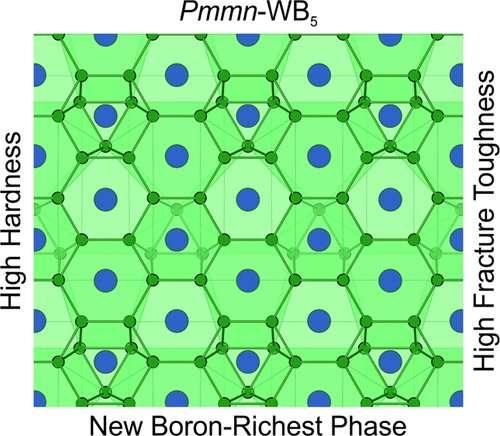Scientists predict a new superhard material with unique properties

This is a schematic caption of new material's structure. Credit: Alexander G. Kvashnin et al./The Journal of Physical Chemistry Letters
Superhard substances have a broad scope of application spanning well drilling, machine building, metalworking, defense industry, surgery and many other fields. The hardest known material, diamond is an unaffordable luxury in many applications.
Its distant competitor, pobedit, has remained unrivaled for the last 80 years. Developed in the 1930s, it was used during the Second World War to make anti-tank shell caps (the word 'pobedit' is actually derived from the Russian 'pobeda' which means victory) and has been used for decades to manufacture drill bits for the drilling rigs. Harder materials either require higher-pressure synthesis or have much lower fracture toughness.
A team of Skoltech scientists led by Professor Artem Oganov used their USPEX evolutionary algorithm to predict a new material, WB5, that can be synthesized at normal pressure and can successfully compete with pobedit in the two most essential parameters ? hardness and fracture toughness ? which are 50% higher and 20% lower, respectively, for WB5 as compared to pobedit.
The new material is a previously unknown compound that can be easily obtained under normal conditions. The Skoltech scientists performed their study within the framework of Gazprom Neft's large-scale project aimed at creating new materials for drilling applications.
“Before we discovered the new material, we had studied a lot of systems on the computer, trying to predict stable chemical compounds and calculate their properties. These were quite interesting substances, although they could hardly compete with pobedit. At some point I thought we would never beat pobedit which has stood its ground for almost a century ? and for good reason. But suddenly we saw a glimmer of hope and soon found a unique compound, WB5,” says the study lead Artem Oganov.
“The tungsten-boron system has been the subject of a multitude of experimental and theoretical studies, and it is surprising that this compound has not been discovered till now,” says the first author Dr. Alexander Kvashnin.
Media Contact
All latest news from the category: Materials Sciences
Materials management deals with the research, development, manufacturing and processing of raw and industrial materials. Key aspects here are biological and medical issues, which play an increasingly important role in this field.
innovations-report offers in-depth articles related to the development and application of materials and the structure and properties of new materials.
Newest articles

First-of-its-kind study uses remote sensing to monitor plastic debris in rivers and lakes
Remote sensing creates a cost-effective solution to monitoring plastic pollution. A first-of-its-kind study from researchers at the University of Minnesota Twin Cities shows how remote sensing can help monitor and…

Laser-based artificial neuron mimics nerve cell functions at lightning speed
With a processing speed a billion times faster than nature, chip-based laser neuron could help advance AI tasks such as pattern recognition and sequence prediction. Researchers have developed a laser-based…

Optimising the processing of plastic waste
Just one look in the yellow bin reveals a colourful jumble of different types of plastic. However, the purer and more uniform plastic waste is, the easier it is to…



